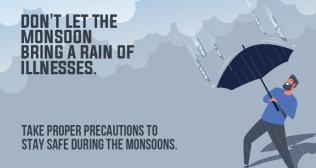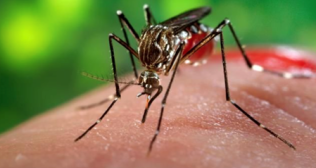
Fever Treatment in Mumbai
Fever: Causes, Symptoms and Treatment Of This Mumbai Monsoon Malady
Overview
Fever is one of the most common reasons people visit a hospital, especially during seasonal shifts and monsoon months. Often seen as a symptom rather than a disease, fever is the body’s natural response to infection, inflammation, or illness.
It signals that the immune system, the body's defence mechanism against diseases, is actively fighting against an invader - virus, bacteria, or other pathogens. While most fevers are mild and self-limiting, there are instances when a temperature rise could be a warning sign of a serious underlying condition.
At Fortis Hospitals, Mulund, we are committed to equipping individuals with the proper knowledge to take timely action, especially during high-risk periods like Mumbai’s monsoon season, where fever cases surge dramatically. With our extensive experience and expertise in healthcare, we are here to guide you through this health concern.
What Causes a Fever?
Fever results from the body’s internal thermostat, located in the hypothalamus, being reset to a higher temperature in response to an illness or inflammation. The causes can range from common viral infections to serious bacterial or parasitic diseases.
In Mumbai and its surrounding areas, especially during and after the onset of monsoon, fever is most frequently caused by infections such as malaria, dengue, leptospirosis, chikungunya, typhoid, and seasonal flu. Viral fevers due to upper respiratory tract infections are rampant during this time, often accompanied by symptoms like cold, cough, and body aches.
In some cases, fever may be triggered by autoimmune diseases, certain medications, or heat-related illnesses. Given the broad spectrum of potential causes, a detailed clinical evaluation is critical for accurate diagnosis and effective treatment.
Are Fevers On The Rise During Mumbai Monsoons?
The onset of the monsoon has brought a noticeable rise in vector-borne diseases in Mumbai. This year, local health authorities have reported a sharp increase in malaria and dengue cases, especially in densely populated and low-lying areas with poor drainage and stagnant water accumulation.
The month of April 2025 alone saw more than 1,400 reported malaria cases in Mumbai, accounting for over half of the state’s caseload. Dengue is also on the rise, with seasonal fluctuations pushing numbers upwards even before peak monsoon hits. Additionally, chikungunya and seasonal flu cases have seen a resurgence, with outpatient departments in many hospitals witnessing a steady inflow of patients presenting with fever, joint pain, fatigue, rashes, and respiratory symptoms.
The humid, waterlogged environment creates an ideal breeding ground for mosquitoes, making preventive awareness and early medical intervention more critical than ever.
Types of Fever and What They Mean?
Fever can present in different patterns, and understanding these can often offer clues about the underlying condition. A low-grade fever, typically ranging between 99°F to 100.4°F (37.2°C to 38°C), is usually linked to minor viral infections or post-vaccination responses.
Moderate-grade fevers, between 100.4°F and 102.2°F (38°C to 39°C), are seen in illnesses like influenza or uncomplicated cases of malaria and typhoid.
When body temperature crosses 102.2°F (39°C), it is termed a high-grade fever, often pointing to more serious infections such as dengue, severe bacterial pneumonia, or bloodstream infections.
Some fevers, such as typhoid, may be intermittent, coming and going in cycles, as seen in malaria, while others may be continuous. In rare cases, persistent fever without known cause could indicate autoimmune diseases, tuberculosis, or malignancy.
The type, pattern, and duration of fever all help doctors make an accurate diagnosis.
Recognising the Symptoms Associated with Fever: Early recognition of fever and its associated symptoms is crucial. It empowers you to take timely action and seek medical care, thereby preventing complications and reducing the risk of severe outcomes.
Fever seldom occurs in isolation. It is typically accompanied by various symptoms that provide clues about its origin. Common signs include body chills, shivering, muscle aches, weakness, sweating, and headache.
Depending on the cause, fever may also be associated with respiratory symptoms such as sore throat, cough, or nasal congestion, as seen in viral flu. In dengue or chikungunya cases, patients often report severe joint and muscle pain, eye pain, rash, and nausea.
Malaria tends to present with cyclic chills followed by sweating and extreme fatigue. Some fevers include gastrointestinal symptoms like vomiting, diarrhea, or abdominal cramps.
Dengue, in particular, has sure warning signs like persistent vomiting, severe abdominal pain, mucosal bleeding (from gums or nose), or a sudden drop in platelet count, all of which require immediate hospitalization. Recognizing these signs early and seeking medical care can prevent complications and reduce the risk of severe outcomes.
Treatment Options and What to Expect at Fortis Hospitals, Mulund
The treatment of fever depends entirely on the underlying cause. Supportive care with adequate hydration, rest, and fever-reducing medications like paracetamol is sufficient for most viral fevers.
However, self-medication must be avoided, especially with drugs like ibuprofen or aspirin, which can worsen outcomes in cases like dengue by increasing bleeding risk. It's crucial to seek professional medical advice and follow the prescribed treatment plan. Based on blood cultures and sensitivity reports, antibiotics are prescribed for bacterial infections such as typhoid or pneumonia.
Malaria is treated with specific anti-parasitic medications, while dengue and chikungunya require close monitoring of blood counts, fluid management, and symptom control.
At Fortis Hospitals, Mulund, we offer advanced diagnostic testing, including rapid tests for malaria and dengue, blood cultures, complete blood counts, chest X-rays, and other imaging studies when necessary.
At Fortis Hospitals, Mulund, we ensure comprehensive care for fever management. Our experienced physicians tailor treatments to suit the individual’s clinical condition, age, medical history, and severity of symptoms. We also have critical care units equipped to handle complications such as dengue shock syndrome, sepsis, or multi-organ dysfunction, ensuring your safety and well-being.
When Is A Fever A Medical Emergency?
While most fevers resolve with rest and basic care, there are red flags that should never be ignored. A fever becomes a medical emergency if it persists for more than five days, crosses 103°F (39.4°C), or is accompanied by symptoms like confusion, persistent vomiting, chest pain, rapid breathing, fainting, or signs of dehydration such as dry mouth, sunken eyes, or reduced urine output.
Children with febrile seizures, elderly individuals with pre-existing health conditions, and pregnant women should seek medical attention without delay. Fever with bleeding, low blood pressure, a rapid drop in platelet counts, or altered consciousness, particularly during dengue or malaria outbreaks can be life-threatening and warrant urgent hospitalization.
Contact our emergency department immediately if you or a loved one is experiencing any of these.
Why Choose Fortis Hospitals, Mulund for Fever Management?
Fortis Hospitals, Mulund, has been at the forefront of delivering quality, compassionate care to the community. During high-incidence periods such as the monsoon months, our infectious disease specialists, internal medicine experts, and emergency care teams are fully prepared to diagnose and treat all fever-related illnesses.
With state-of-the-art laboratories, 24/7 emergency services, intensive care units, and a commitment to evidence-based protocols, we ensure patients receive the best possible outcomes. Our emphasis is on treating the illness and empowering individuals through awareness, preventive education, and post-recovery guidance.
Fever may be a common symptom, but it can carry uncommon risks, especially during Mumbai’s challenging monsoon season. Staying alert, recognizing the signs early, avoiding self-medication, and consulting experienced doctors at the first sign of trouble can prevent complications and save lives.
Categories
Clear allMeet the doctor

- Internal Medicine | Internal Medicine | General Physician
-
17 Years
-
1500


















